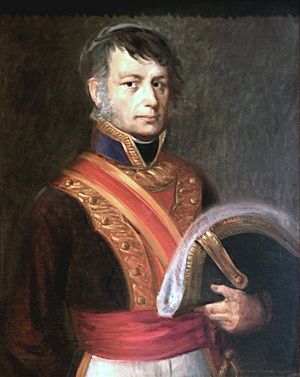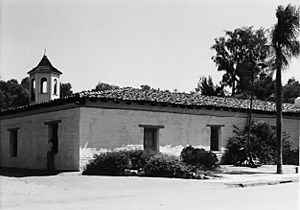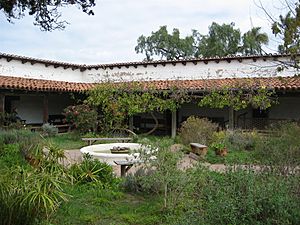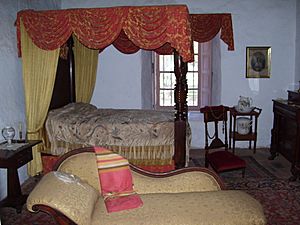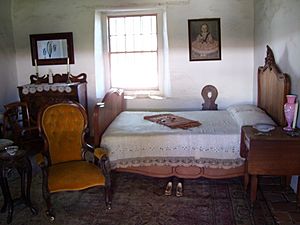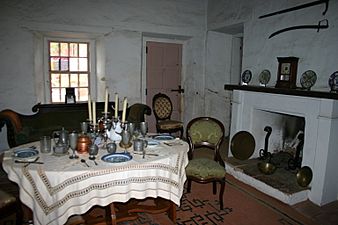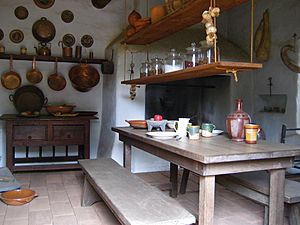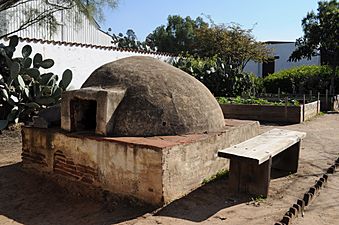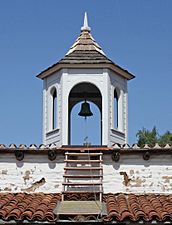Casa de Estudillo facts for kids
|
Estudillo House
|
|
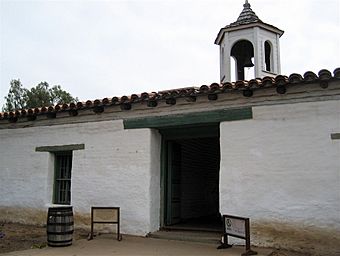
Main entrance
|
|
| Lua error in Module:Location_map at line 530: Unable to find the specified location map definition: "Module:Location map/data/US" does not exist. | |
| Location | 4000 Mason Street, San Diego, California |
|---|---|
| Built | 1827 |
| Architectural style | Spanish Colonial |
| NRHP reference No. | 70000143 |
Quick facts for kids Significant dates |
|
| Added to NRHP | April 15, 1970 |
| Designated NHL | April 15, 1970 |
The Casa de Estudillo, also known as the Estudillo House, is a very old adobe house in San Diego, California. It was built in 1827 by José María Estudillo and his son José Antonio Estudillo. They were important early settlers in San Diego.
This house was once considered one of the most beautiful homes in Mexican California. Today, you can find it in Old Town San Diego State Historic Park. It is recognized as both a National Historic Landmark and a California Historical Landmark.
The Casa de Estudillo is one of the oldest examples of Spanish building style in California. It became very famous because of a popular book called Ramona. This novel, written in 1884 by Helen Hunt Jackson, told a romantic story about life in California. The Estudillo House is one of three important places in Southern California linked to the Ramona story.
Contents
What the House Looks Like
The Estudillo House is shaped like a large "U". It measures about 34 meters (113 feet) on the front side. Each of its two wings is about 30 meters (98 feet) long. It was built in the Spanish Colonial style. This means its 13 rooms are placed one after another. They are connected by an outside covered walkway called a corredor. There are no inside hallways.
The main entrance faces west. To the left of the entrance is a chapel. To the right is a schoolroom. These rooms were originally smaller. Bedrooms were at the very ends of the building. However, a restoration in 1910 made these rooms larger.
The north wing of the house has two bedrooms, a living room, a kitchen, and a dining room for servants. The south wing has three bedrooms and the family dining room. On top of the house, there is a small tower called a cupola. From here, people could watch events in the nearby plaza.
The Ramona Story
How the House Became Famous
José Antonio Estudillo passed away in 1852. His family lived in the house until 1887. Then, they moved to Los Angeles and left a caretaker in charge. Around this time, the book Ramona became very popular. It described life in Southern California in a romantic way. This book made many people across the country interested in visiting the region.
Many tourists came to Southern California to see the places from the novel. The author, Helen Hunt Jackson, died in 1885. She never told anyone the exact real-life locations that inspired her book. This led to a lot of guessing and speculation.
In 1887, a newspaper called the San Diego Union printed a front-page story. It said the Estudillo home was "Ramona's Marriage Place." This was even though Jackson had never visited the house. In the novel, Ramona was married in an old, decaying adobe building. Visitors believed this was the actual place where Ramona got married. The caretaker of the house decided to make money from this fame. He started selling pieces of the house as souvenirs. Because of this, the building quickly started to fall apart.
The 1910 Restoration
In 1906, a wealthy San Diego citizen named John D. Spreckels bought the run-down building. He also owned the Union newspaper. Spreckels wanted the house to be a main attraction for tourists. He planned to connect it to other sites using his railway system. His goal was to make San Diego a popular place to visit.
Spreckels hired an architect named Hazel Wood Waterman. She was asked to fix up the house. Her goal was to make it look more like the descriptions in the Ramona novel. The original cupola and balcony were removed because they were not mentioned in the book. Some doors and windows were also moved. Waterman wanted the building to look old. She also wanted it to have the "charm of work done by less skilled Indian hands." However, modern things like electricity and indoor plumbing were added.
When the restoration finished in 1910, the house was promoted as a Ramona tourist spot. It remained very popular for many years. On one day in 1940, it attracted 1,632 visitors.
Spreckels hired Tommy Getz to manage the property. Getz was a showman. He made the house even more famous for its Ramona connection. He sold all kinds of small items labeled "Ramona's Marriage Place." More postcards were printed for this adobe than any other Ramona attraction. Because of its link to Ramona's marriage, the house also became a popular place for real weddings. Getz eventually bought the adobe from Spreckels in 1924.
The house became so strongly linked to the novel that its application for National Historic Landmark status was called "Casa Estudillo/Ramona's Marriage Place." Some people even say that without the novel's influence, the historic buildings in Old Town San Diego might have been torn down. For a while, people almost forgot that the Estudillo family had originally owned the house.
After Getz passed away in 1934, his daughter, Margeurite Weiss, continued to run the business for 30 more years. She finally sold it in 1964. The house was then donated to the State of California in 1968.
The 1968 Restoration
The state's Park Service began to restore the house. They wanted it to look like it did before it became famous from Ramona. This included putting the missing cupola back. The house is now a museum. It is furnished to look like it would have when the Estudillo family lived there. A kitchen was added, which was not part of the original design.
At first, the state seemed a bit shy about the house's connection to the novel. The old "Ramona's Marriage Place" sign was taken down. Brochures printed in the 1970s did not mention the novel at all. However, by the 1990s, the state started to recognize the long history the house had with the book.
Today, the novel Ramona is not as widely known as it once was. It is thought that only about 1% of visitors to the Casa de Estudillo now know about its ties to the book.
Photo gallery
See also
 In Spanish: Casa de Estudillo para niños
In Spanish: Casa de Estudillo para niños


